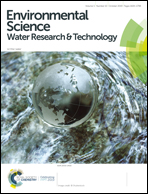Degradation of ibuprofen and acetylsulfamethoxazole by multi-walled carbon nanotube catalytic ozonation: surface properties, kinetics and modeling†
Abstract
In this study, multi-walled carbon nanotubes (MWCNTs) with and without HNO3 pretreatment were employed as catalysts in catalytic ozonation for the removal of two pharmaceuticals and personal care products (PPCPs), ibuprofen and acetylsulfamethoxazole. The rate constants of MWCNTs in terms of direct ozone reaction (kD), initiation (kI), promotion (kP) and inhibition (kS) in the hydroxyl radical (OH˙) chain reactions were quantified. It was found that kD and kI increased with increasing solution pH and HNO3 concentration used in the pretreatment, while kP and kS showed the opposite trend. These trends could be attributed to the abundance of oxygen-containing functional groups including hydroxyl, carbonyl and carboxyl groups on the MWCNT surfaces resulting from HNO3 pretreatment. The removal of ibuprofen and acetylsulfamethoxazole was improved when MWCNTs were used as the catalyst due to enhanced OH˙ formation, which could be quantified using the determined rate constants. A kinetic model incorporating the rate constants of MWCNTs in the direct ozone reaction and OH˙ chain reactions can be used to predict the removal of contaminants in catalytic ozonation.



 Please wait while we load your content...
Please wait while we load your content...